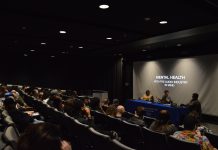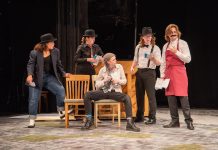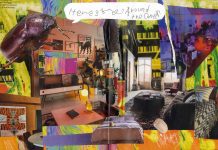Four different backgrounds, inspirations showcase in senior dance BFA
By: Morgan Stache
Senior dance majors Julie Opiel, Raii Saleems Morehead, Audrey Simes and Matthew Schmitz prepared since April to show off their individual creativity, technique and choreographic ability in the dance department’s senior BFA performance, “Witness.” It’s a cumulation of solo, duet and group dances — the result of months of choosing sound scores, rehearsals and working through the technicalities of comprising an entire show. Performances run Nov. 3-5 in Stage 3.

Julie Opiel
For Julie Opiel, dance started out as a hobby, something her parents put her in to keep her active. Since then, it has become central to her life and her future.
“I’ve been dancing since I was two years old. It became this huge part of my life,” Opiel said. “This is what I love and what I’m going to stick with. I’ve grown a lot at Webster, which kind of connects back to my solo idea. It’s about this journey of self-acceptance, my journey as an artist and how it’s kind of a roundabout thing.”
Opiel worked with five other students in the dance department in her group piece. She said the group dynamic made her change her view of the number and helped the dance develop.
“There’s a lot of stuff that changes (with the dances),” Opiel said. “You have an idea and then it comes through differently, but I’m okay with the changes that have happened. I’m really proud of my dancers. I think they look awesome.”
Techniques and artists in various mediums inspired Opiel — all of which can be seen in her performances and choreography.
“I love Mary Oliver, the poet, and the natural aspect of her work. It goes well with my sound score,” Opiel said. “I worked with (Alonzo King) for two summers and am very inspired by his work. His movement is like no one else I’ve ever seen.”
Opiel is graduating at the end of the fall semester, earlier than her fellow classmates. She plans on continuing her dance career and has already lined up opportunities.
“Come January, I’m auditioning a lot for companies. I actually have a project that I’m hopefully going to secure. I would like to be choreographing if I can,” Opiel said.

Raii Saleems Morehead
Raii Saleems Morehead’s unique movement has developed from years of break dancing and gymnastics training.
“My movement vocabulary sits upon my training in break dancing,” Morehead said. “I’ve also done gymnastics, and my father was a martial artist. So my movement history — what makes up my own particular movement — comes from all the things that influence me. I also have scoliosis so I have to train my body in a specific way that makes me strong.”
Morehead’s group piece, set to the sounds of news broadcasts, has a very specific message to the audience.
“The subject is media consolidation. It’s becoming now that most media in the country is being controlled by (a few) owners, and there’s a monopoly on all these media systems. What the media does is provide ideas through different shows, different movies and different newspapers that promote ways of thinking about certain subjects,” Morehead said. “It deals with how much control a person has (over) what information they get. I explored that a lot, and showing that in movement is hard.”
Morehead has come up with a metaphor to explain to people how he views a career in dancing.
“I’ve come across a lot of people who, when they find out I’m a dancer, they question what I can do with dance. With hard work, I can figure out how to explain things with my medium,” Morehead said. “From a business stand point, it’s a product that you’re producing for an audience. They are giving you a finance to wake them up, teach them something or entertain them. If you can do it all, good. If you can do one, that’s good too.”

Audrey Simes
Audrey Simes’ choreography explores a crucial concern of college students today — the environment.
“The pieces are based on the aspects of the third nature and the idea that humans evolved from living in a coexistence with nature, then into using the earth for our own personal gain, for agriculture and work,” Simes said. “I think it’s the most important issue of our time, the climate change.”
Talking about the time and effort each senior has put into this project, Simes explained this process, while exciting, was a challenge.
“I don’t know that I could even quantify (the number of hours this took). An immense amount of work goes into this project because we actually started at the end of last year in our composition class,” Simes said. “We started discussing the process and scheduling our showings last year. My rehearsals tend to be two to three hours each and I currently have three or four rehearsals a week, and that’s been going on since close to the beginning of the semester.”
Simes said she hopes to get the audience to consider their part and impact on the world around them.
“Basically, (I want to) raise questions about how individuals interact with the environment. I usually tend to make works that are much more in your face and get people a little bit offended sometimes,” Simes said. “But, I wanted to use this as an opportunity to allow people to do their own thinking rather than forcing them to see that we’re all very much a part of this destruction of our environment. I hope that that comes through in an abstract way for this piece.”

Matthew Schmitz
Matthew Schmitz’s pieces reflect his love for ballet, the dance style he wants to pursue as a career.
“I enjoy contemporary ballet. It’s my passion. That’s what I want to do once I graduate. I like that kind of aesthetic and style. You can get deeper into the ground, you can fall off your center and use your spine more,” Schmitz said. “But at the same time, I still like that ballet line and that strength, and technicality aspect.”
When designing the group piece of his collection, Schmitz said he kept his dancers in mind, wanting to challenge them and give them a different style of dance.
“I wanted to choreograph a piece for those dancers that was technically challenging for them so that they can improve in their technique and in their performance,” Schmitz said. “Whenever I was a freshman and sophomore, I got put into pieces that were above my head. The way I developed as a dancer and as a performer was to be in those because they were a step above me. I knew that if I wanted to perform these, I had to get myself to that level no matter what.”
Schmitz said though his first year was overwhelming, he credits Webster with helping him develop his skill.
“My training increased tenfold when I came (to Webster) because of the level of intensity of the classes I was taking. I learned dance isn’t about how many turns you can do or how high your leg can get,” Schmitz said. “It’s about how you move and how you feel when you dance.”



